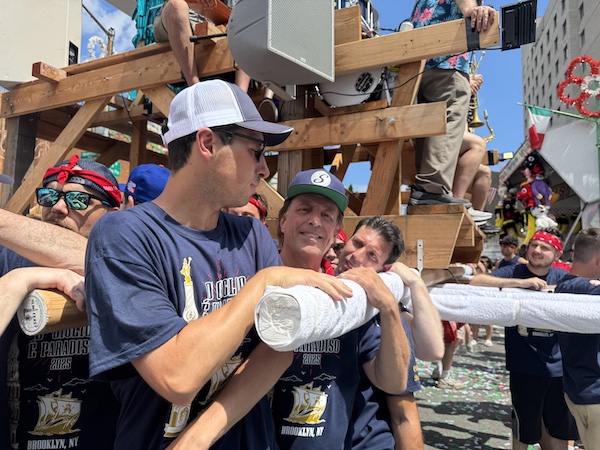By Katie Vasquez and Alexandra Moyen
WILLIAMSBURG — Every year in July for 138 years, the streets outside the Shrine Church of Our Lady of Mt. Carmel come alive with music, Italian pride, and faith as thousands gather for one of New York’s most beloved cultural celebrations: the Dancing of the Giglio.
The Giglio, honoring St. Paulinus — the patron saint of Nola, Italy — is one of the main celebrations of the 12-day feast in gratitude to the Virgin Mary at Our Lady of Mount Carmel. This neighborhood tradition has been part of Williamsburg for over a century, dating back to when Italian immigrants first settled in the area, bringing with them their deep faith and cultural customs.
Andrew Occhiuto, who called Our Lady of Mt. Carmel his “home parish,” ranks the Dancing of the Giglio as one of the most meaningful things in his life. For Occhiuto, the tradition is more than just an event — it’s a lifelong constant. He recalled his childhood days watching the towering statue sway through the streets from the rooftop of the church.
Today, Occhiuto takes pride in passing that same tradition down to his own family, just as his father once did for him.
“I have my wife and my two children. I have my 9-year-old daughter and my 5-year-old son, who are sort of seeing this with the eyes that I got to see it with as a child, and that makes it all the more special,” Occhiuto said. “It was special before, but it is even more special now.”
The base of the Giglio, which is decorated with Gigli flowers, holds a platform where a 12-piece brass band performs during the procession. Throughout the route, the lifters pause at certain points to “dance” the towering structure in rhythm with the music, especially when the band plays the feast’s traditional anthem, “O Giglio e Paradiso,” which has been a central part of Sunday celebrations since 1959.
Accompanying the Giglio, which requires at least 100 people to carry it, is La Barca — a 10-by-10-foot replica of a boat symbolizing St. Paulinus’ return to Italy by sea after his captivity in Turkey. Like the Giglio, the La Barca is lifted and paraded through the streets, playing a central role in the celebration’s rich storytelling and tradition.
As a lieutenant for the Giglio celebration, Occhiuto is involved in picking out lifters, assisting with training, and much more, which he said feels like a year-long job. Although tedious, he said it is worth it because he is surrounded by others who wish to carry on the tradition.
“I live in Whitestone, and there are people who live as far as Long Island, New Jersey, and Connecticut. On this day, we all return home,” Occhiuto said. “That’s why this will keep going. As long as we keep our faith alive and our enthusiasm and our love for this alive, it’ll never end.”
Msgr. Jamie Gigantiello, pastor of Our Lady of Mt. Carmel, which hosts the festival, said he has seen the event grow in both “size and spirit” during his eight years of participating.
He said what makes the feast day so special is how it continues to welcome everyone, including new neighbors, creating a sense of community that “bridges generations.”
“So many people have come, they see it, they want to learn about it, they want to be part of it,” Msgr. Gigantiello said. “It’s so energizing to see them come because we use that moment as an evangelization moment for them, to talk to them, and you’d be surprised how many of them are now coming to church on Sunday.”
John Diesso, who lives in California, hasn’t missed a festival since leaving Brooklyn in 2001. A dedicated lifter since the age of 15, Diesso continues to carry on the tradition, even participating after undergoing cancer surgery two years ago.
The strength to do these lifts comes from his need to honor his late father — “when I come here, I lift with my dad” — whose presence at the festival left a lasting impression not just on their family but on the entire community..
“He had a sausage and pepper stand right at the foot of the stairs of the church,” Diesso said, “and the priest told my mom after he passed away, ‘Teresa, they’ll never sell another food stand there ever again,’ and they haven’t to this day.”
17-year-old Michael Franco said he has been lifting since he was 13, but being a part of the Giglio has been a family tradition since he was a child.
He said the tradition is about family, culture, and love, and it’s what keeps him coming back every year despite living in Middle Village, Queens.
“Continuing the tradition is important to me because we want this feast to be around in 50 years like it’s around today,” Franco said. “One day, if I become a capo (leader), that would be really special to me, because I want my kids to experience what I experienced growing up in this feast.”

At least 100 lifters are needed for the Dancing of the Giglio. The statue, which weighs four tons, holds a 12-piece brass band on the base. (Photo: Alexandra Moyen)